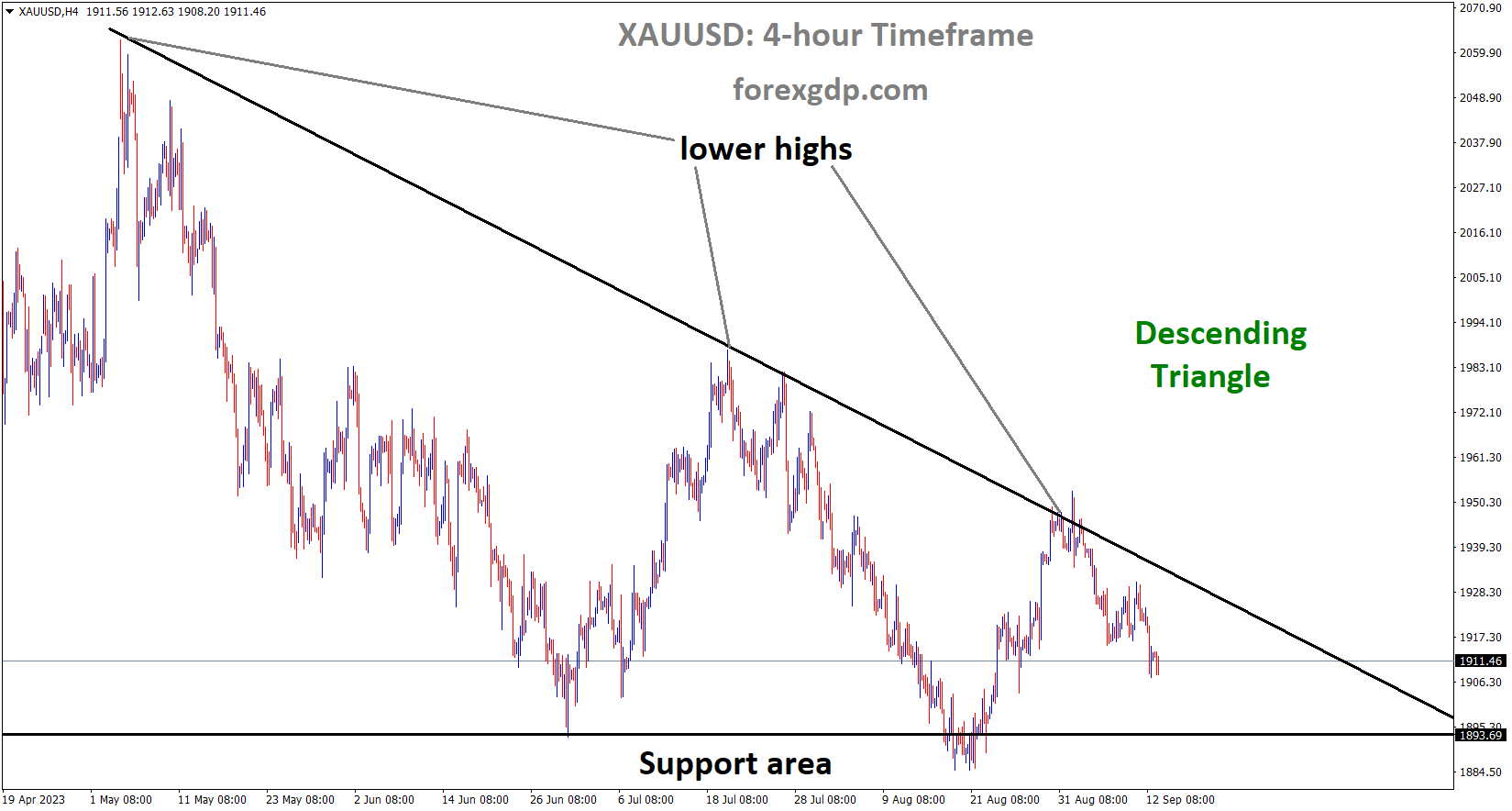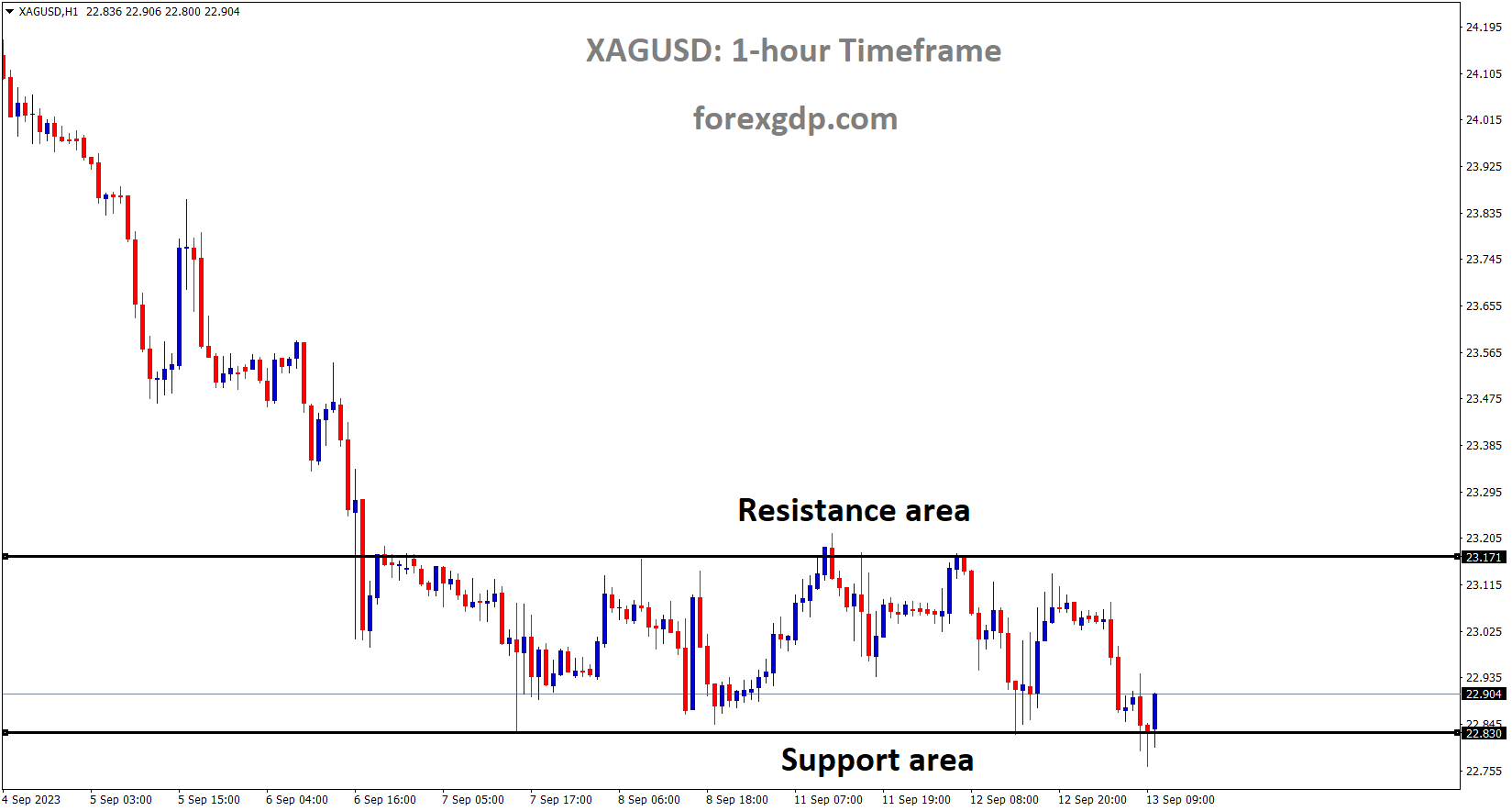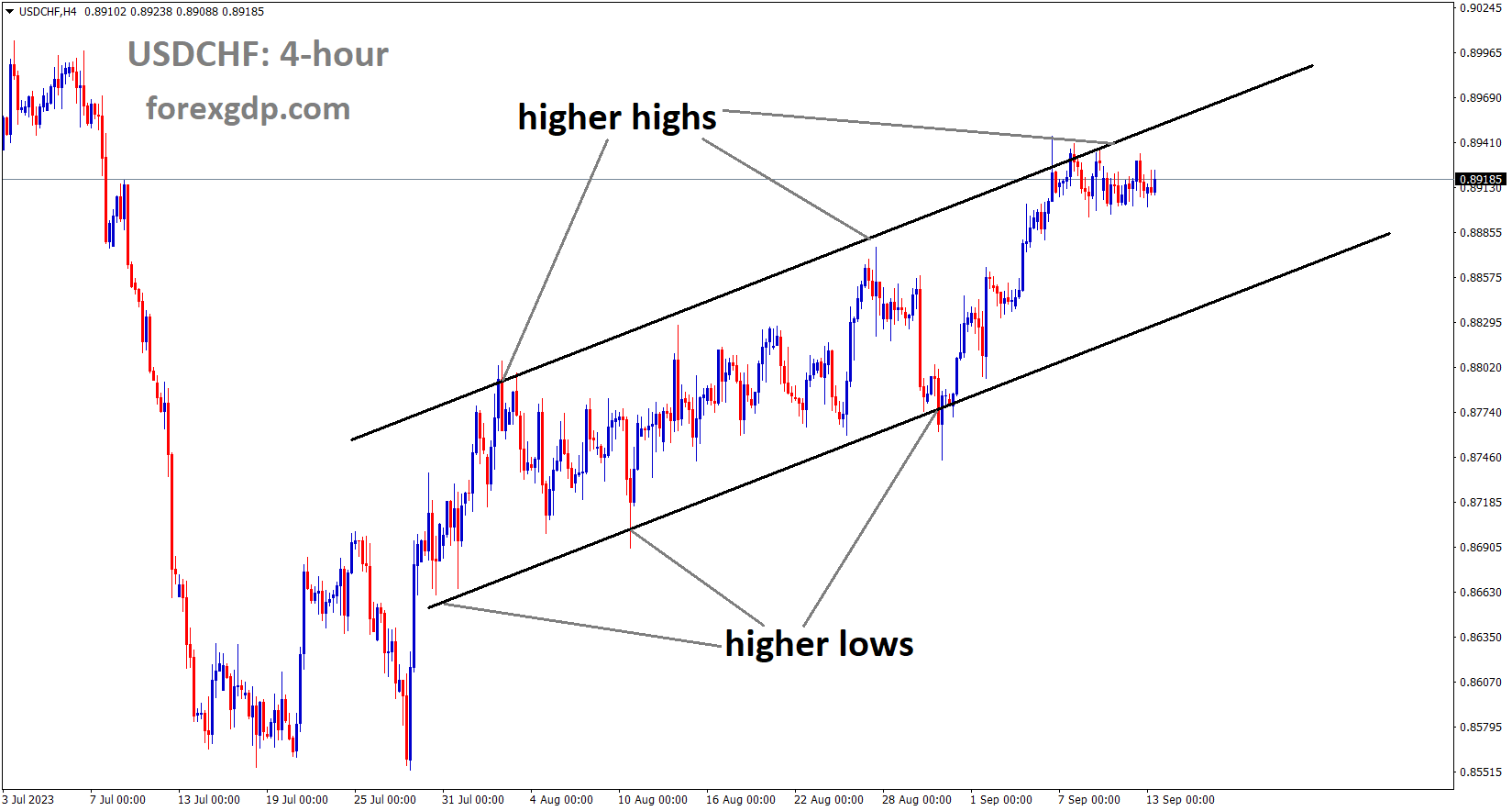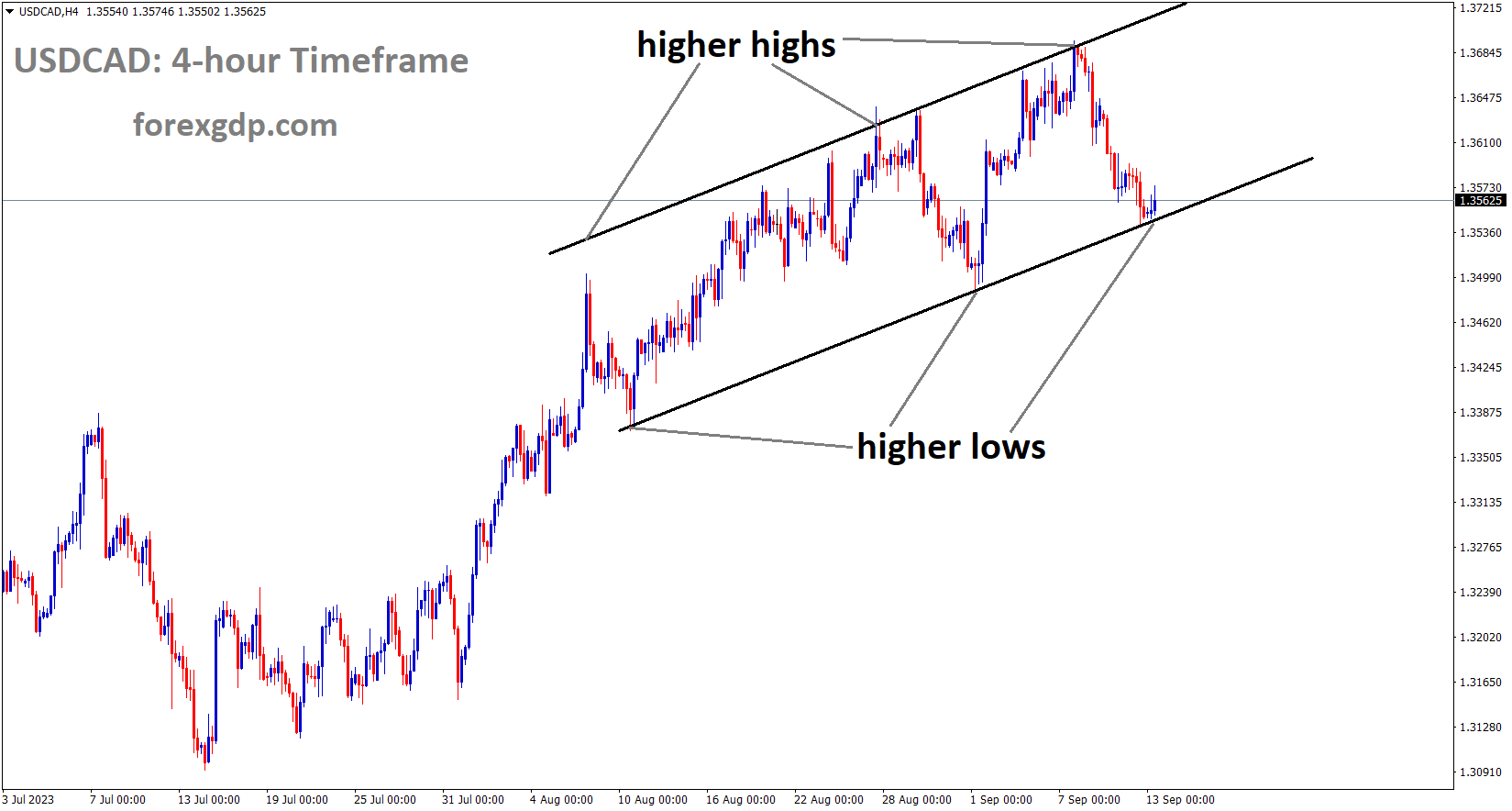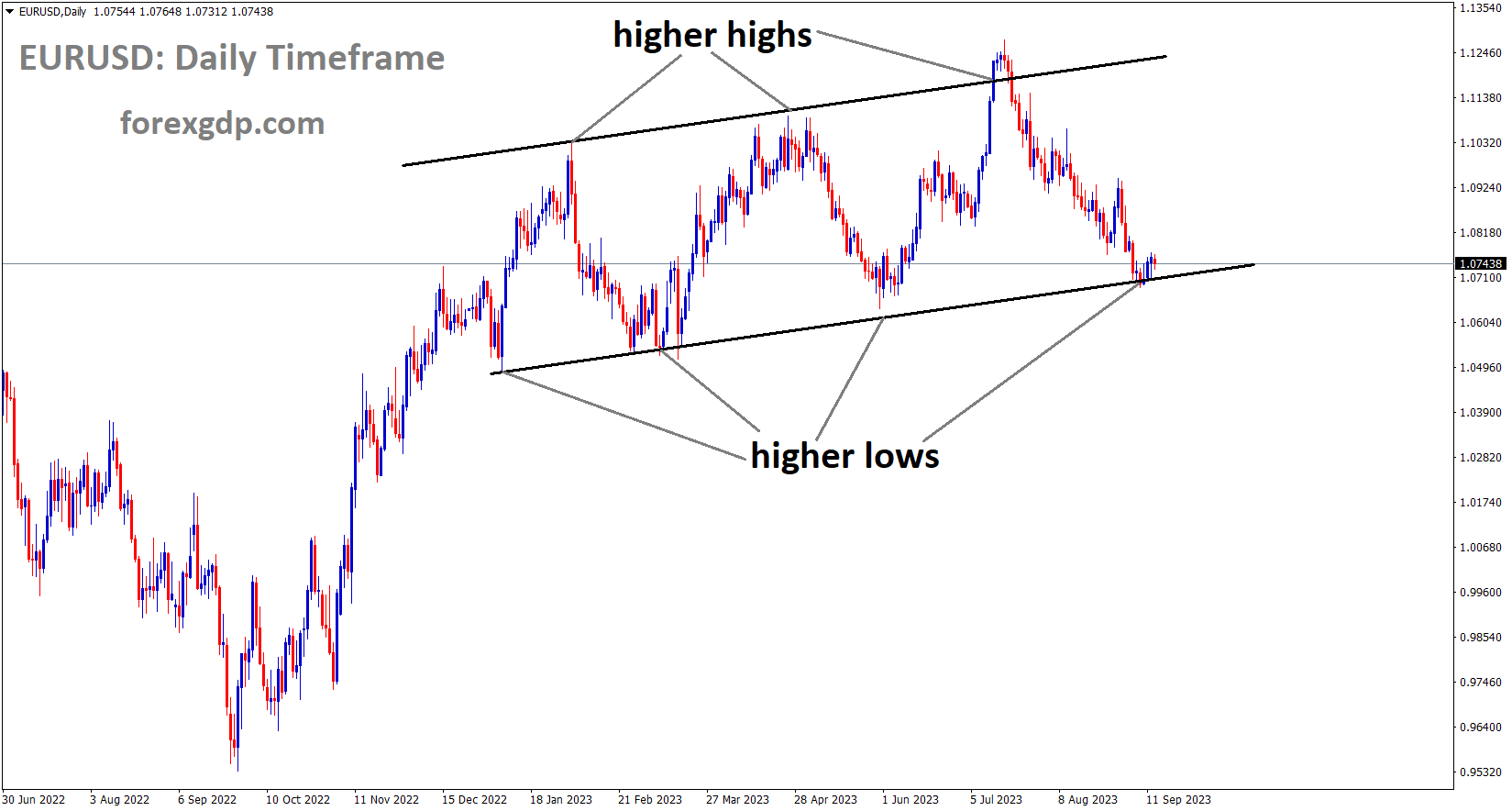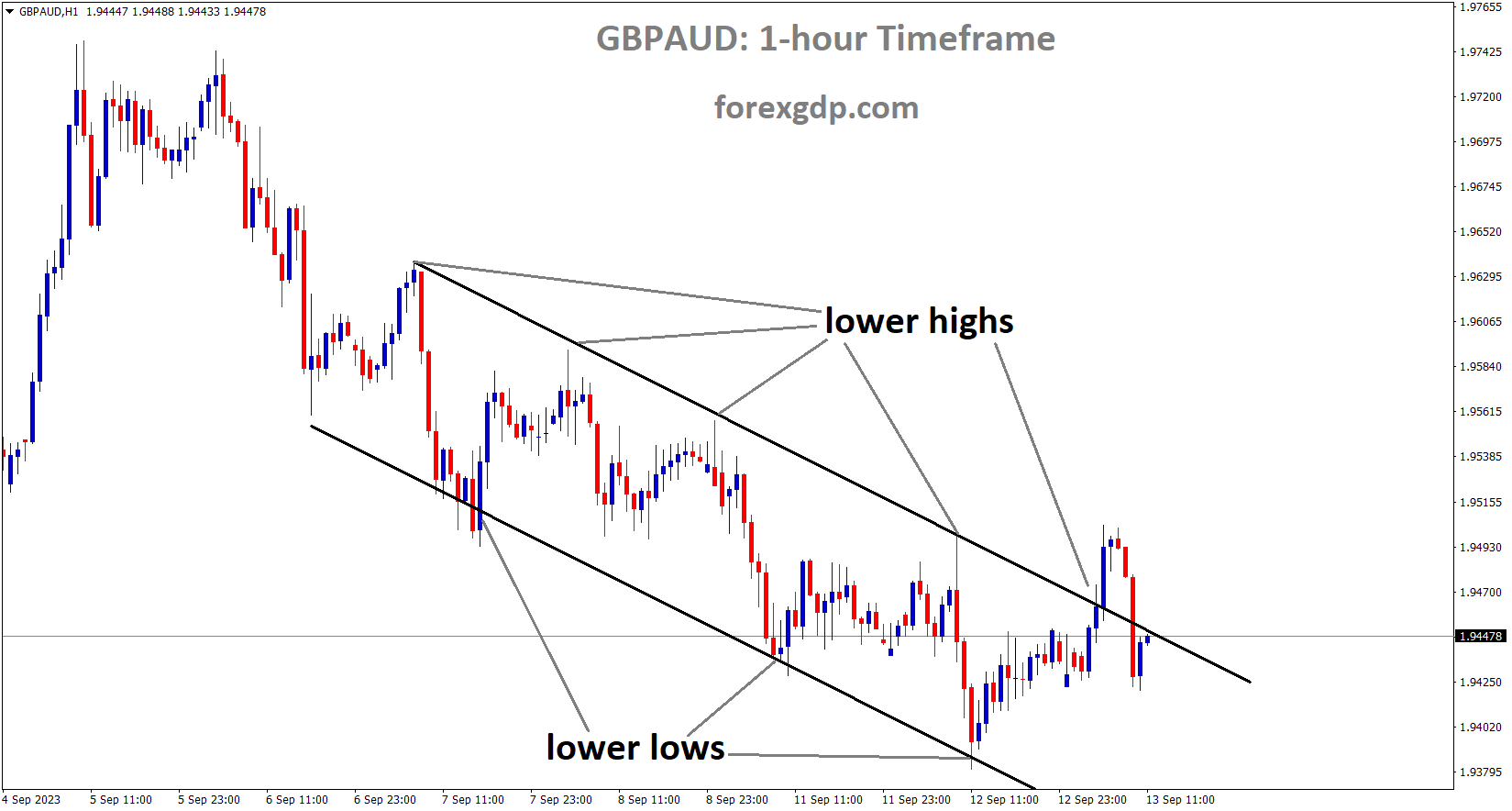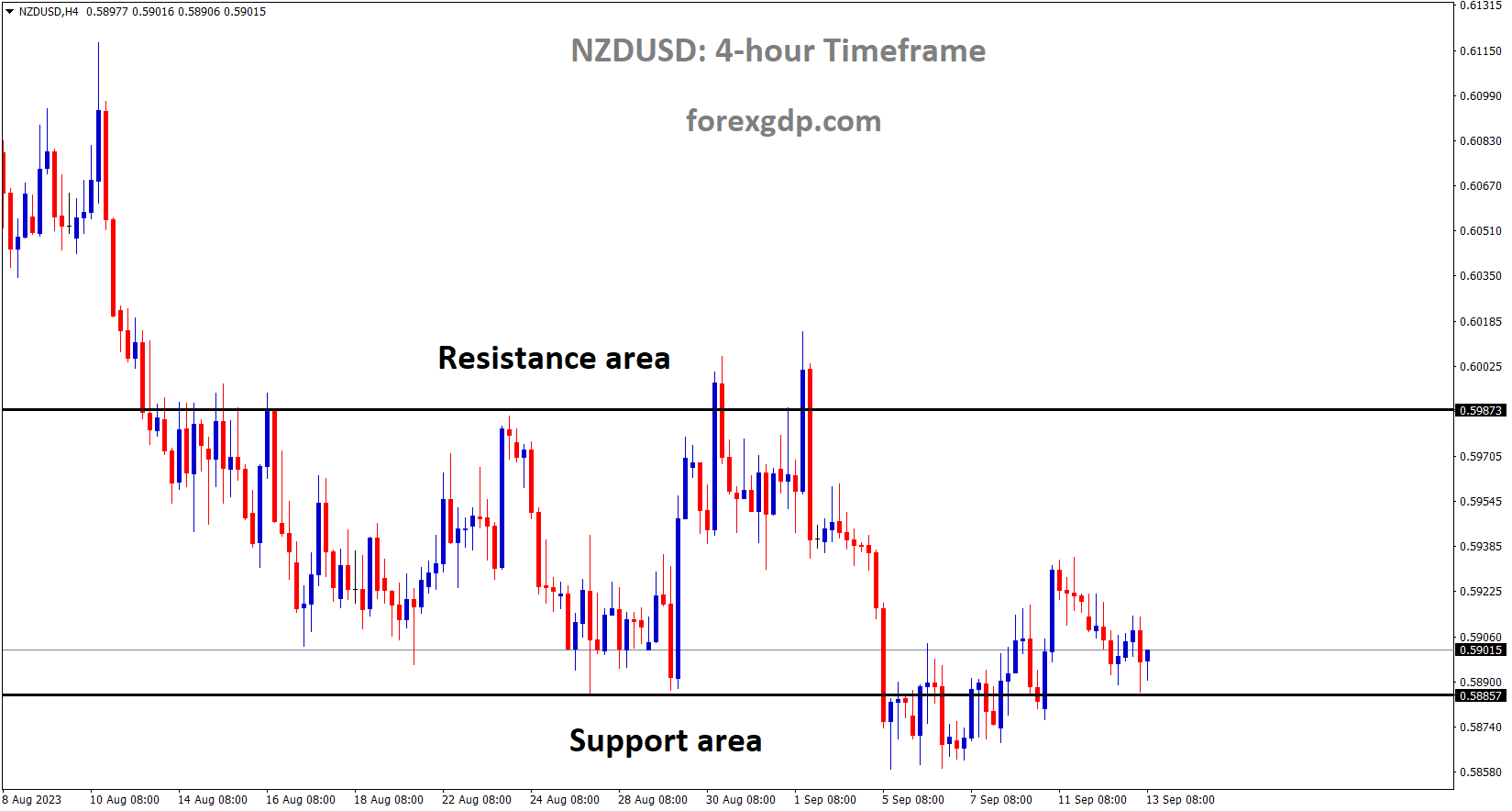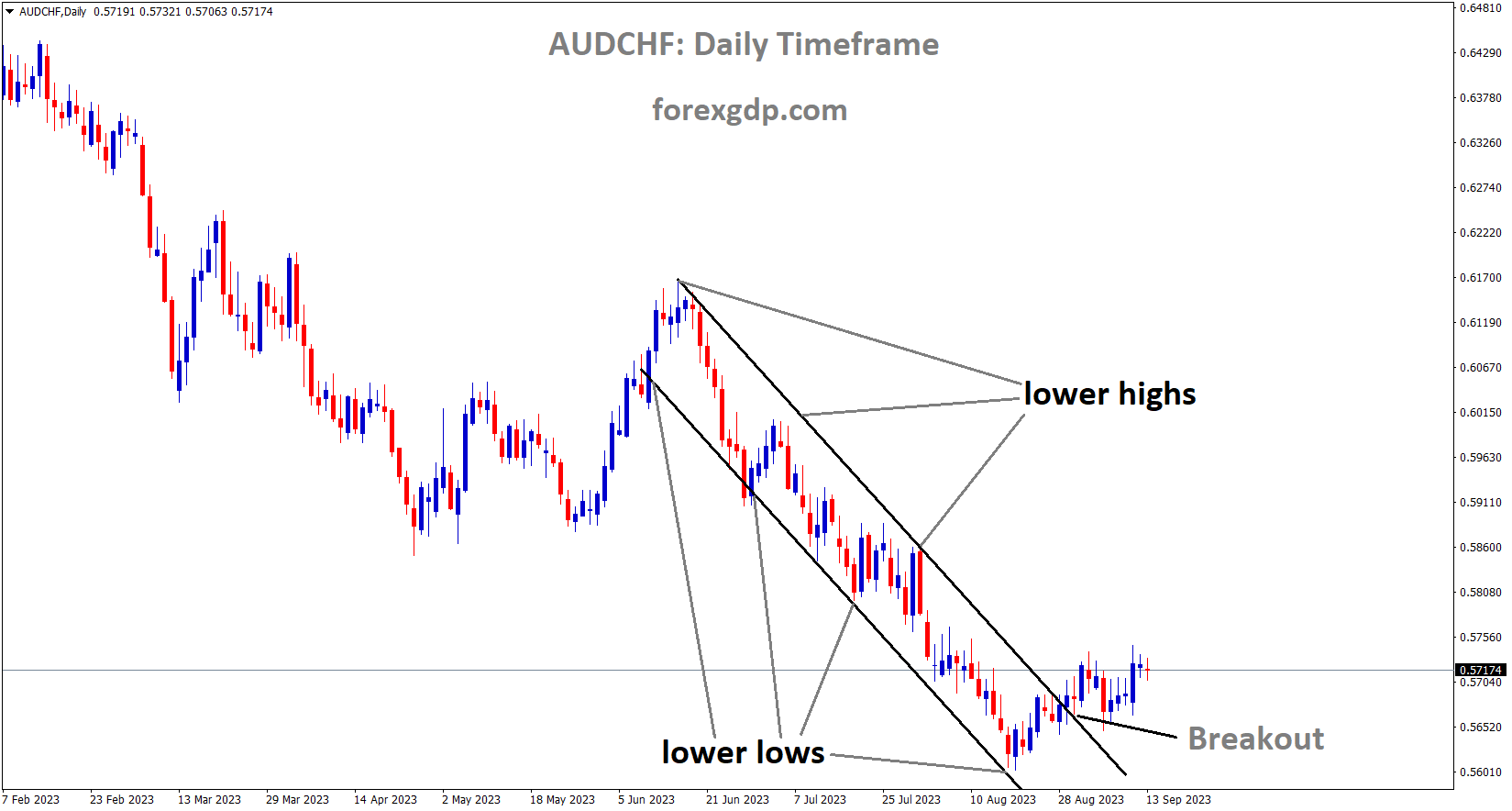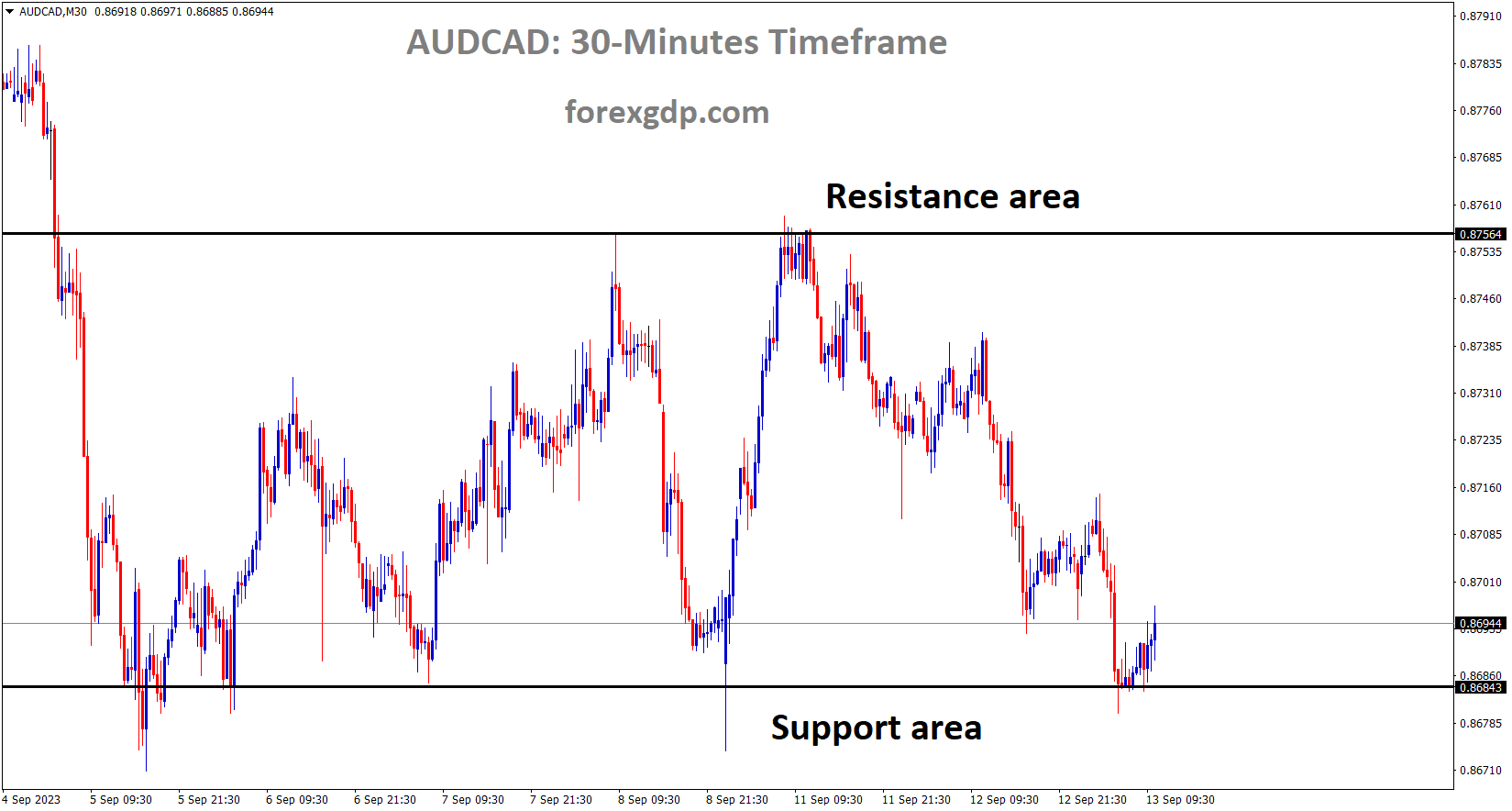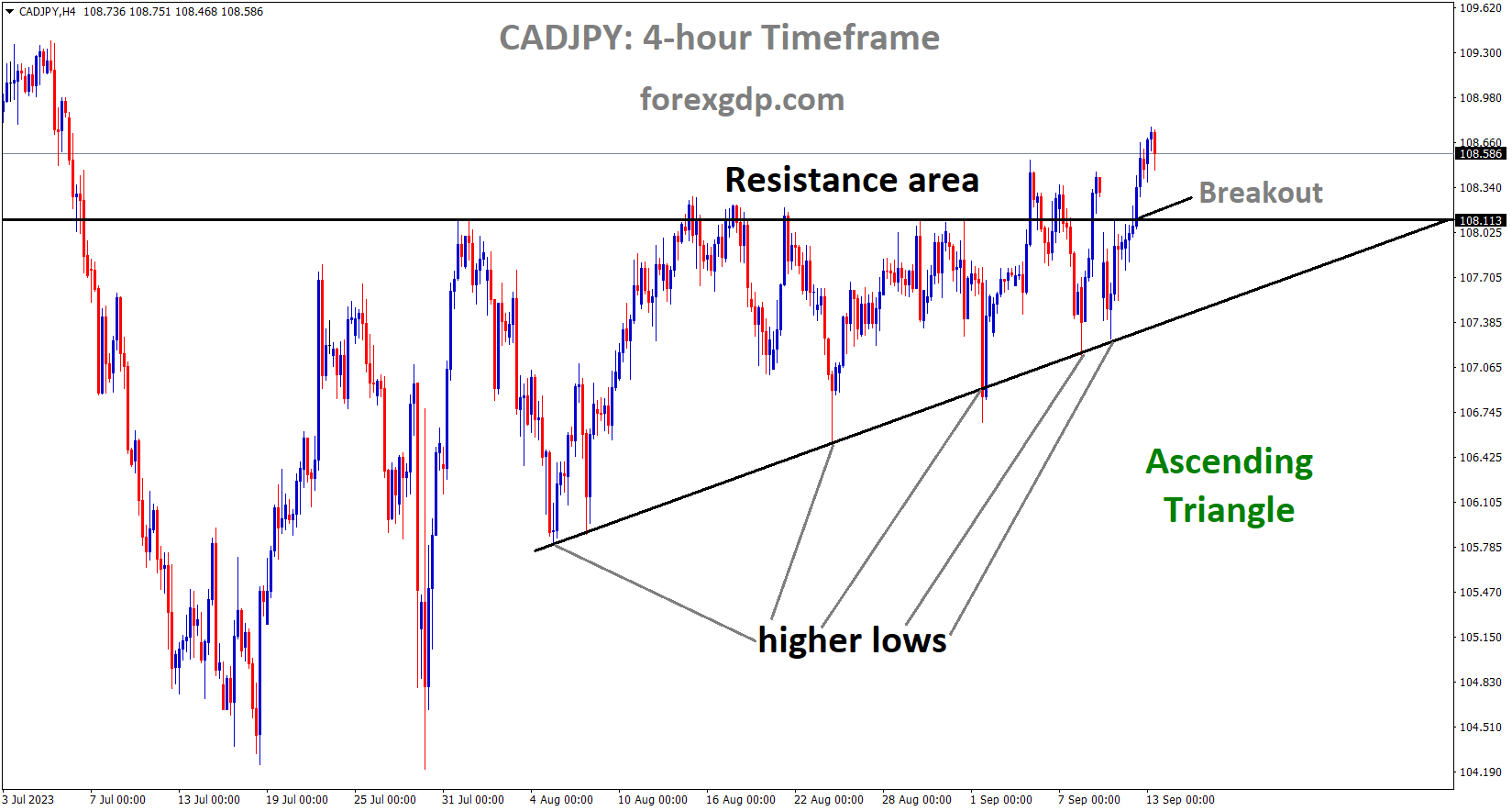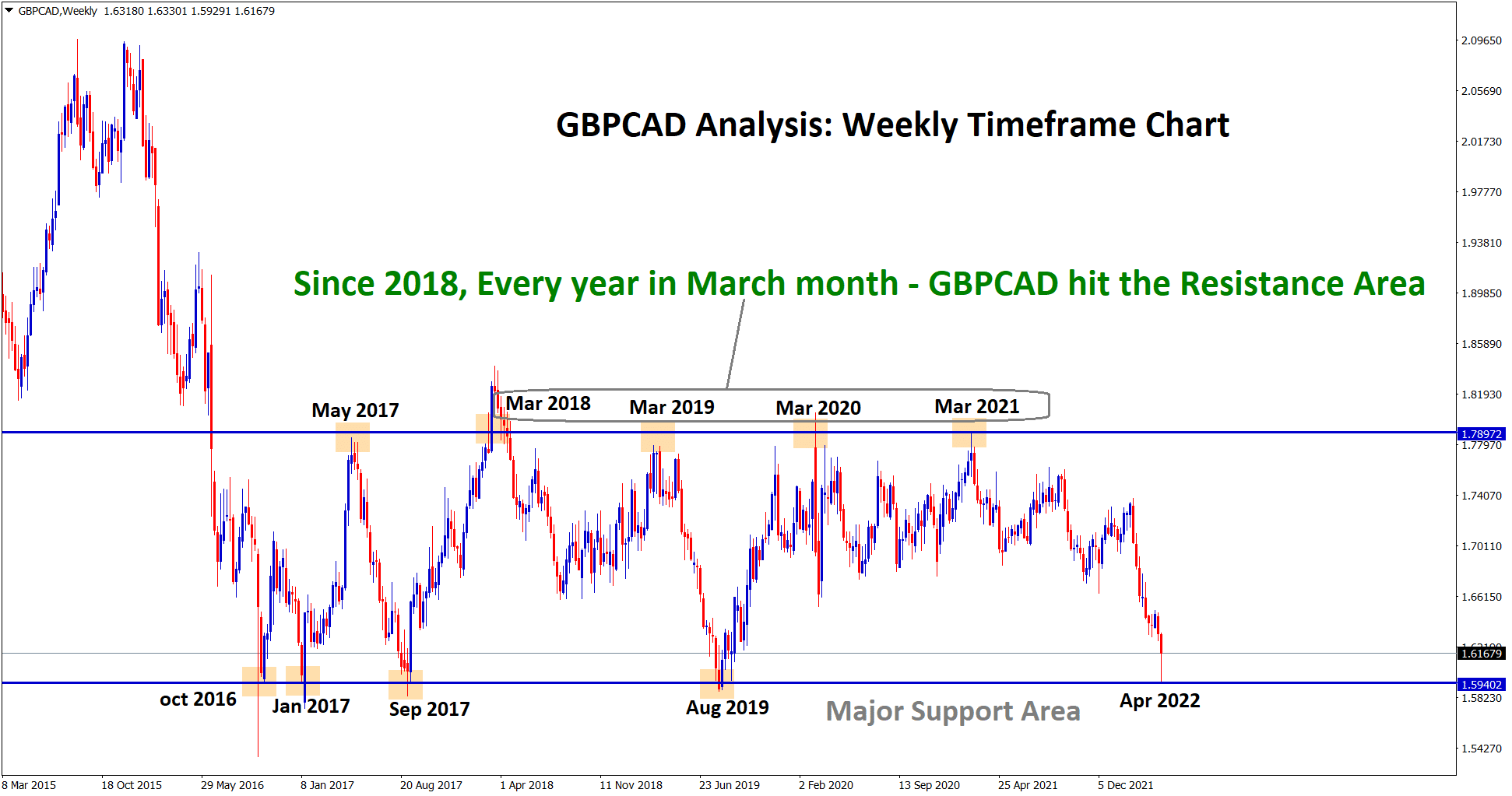XAUUSD Analysis
XAUUSD is moving in Descending Triangle and market has fallen from the lower high area of the channel
The gold price is extending its previous decline as it approaches the $1,900 level. ANZ Bank economists assess the yellow metal’s prospects ahead of key US Consumer Price Index (CPI) data. Gold fell further after a key technical support level was breached, sparking selling. The market is also cautious ahead of the release of US CPI data. Any positive surprises could raise expectations of another rate hike, which would be negative for gold.
XAGUSD Analysis
XAGUSD is moving in box pattern and market has reached support area of the pattern
ANZ Bank economists predicted a drop in the yellow metal gold ahead of today’s US CPI data. The FED will raise interest rates at its next meeting if CPI rises further.
USDCHF Analysis
USDCHF is moving in Ascending channel and market has reached higher high area of the channel
Julius Baer’s chief executive said on Tuesday there was nothing standing in the way of the Swiss bank becoming a $1 trillion wealth manager sometime in the next decade.
On Tuesday, Julius Baer’s CEO stated that nothing stands in the way of the Swiss bank becoming a $1 trillion wealth manager within the next decade. Philipp Rickenbacher, speaking at an LSEG and Reuters Newsmaker event in Zurich, said the bank could double its assets under management to 1 trillion Swiss francs ($1.12 trillion) by the 2030s, though he declined to provide an exact timeline or commit to that figure as a specific goal. Instead, the executive, who has led the bank since September 2019, referred to the figure as a thought hurdle, which Switzerland’s second largest listed bank would overcome primarily through organic growth. We are a growing business. We have proven that over the last decade, and if you look at the long term, there is nothing stopping us from gaining scale in such a rapidly growing market around the world, Rickenbacher said. With current uncertainties surrounding the United States, concerns about the European downturn, and China’s economy slowing, the executive stated that many clients were sitting on cash.
I think the propensity of investors to invest in capital markets today is a little bit muted, he said at the event. While a change in external conditions could boost client confidence, Rickenbacher noted that some uncertainties remained. He sounded cautiously optimistic about the world’s number one and two economies’ resilience, but Julius Baer made it clear that it had no plans for significant expansion in the United States or mainland China. None or only a very few foreign players have ever generated true economic profit through their commercial activities, Rickenbacher said of the US wealth management market, adding that the bank’s current international network was sufficient to generate growth.
When asked if the bank intended to make large investments to expand its onshore business in China, he replied, No, not from our side. He also predicted that Switzerland would maintain its position as the global leader in offshore wealth management, despite the fallout from Credit Suisse’s bankruptcy and rescue by UBS. According to Boston Consulting Group estimates, Switzerland is still the world’s top location for offshore wealth management, with $2.4 trillion under management in 2022. Hong Kong and Singapore, on the other hand, are catching up.
While Credit Suisse’s demise surprised the financial community, Switzerland’s ability to resolve the issue without disrupting the market demonstrates the country’s strength as a financial marketplace. The strength of the Swiss banks, the strength of the Swiss economy, the strength of the Swiss political system… I think this is the foundation to be the preeminent number one financial place for cross-border wealth management, he said at the event. We have a few competitors close behind, but if Switzerland runs fast enough, I believe… we can defend and extend on that position. Still, some regulatory changes were required to protect banks in an era when social media made bank runs more likely and devastating. The executive advocated for a public liquidity backstop to assist banks where clients abruptly withdrew large sums of money, which was the immediate cause of Credit Suisse’s demise. He stated that Julius Baer was focusing on organic growth to achieve its goals, and that the bank planned to hire up to 200 wealth managers this year. Buying other banks to increase the bank’s size, on the other hand, would be more difficult, he said, because other banks would be reluctant to sell up. To put it bluntly, I believe the M&A market is still dead, Rickenbacher said. Everyone is and wants to be in wealth management, and everyone sticks to it, even if they are not as efficient or effective as others. He refused to comment on rumours linking Julius Baer to the Swiss bank EFG International. I believe that organic development must be prioritised.
USDCAD Analysis
USDCAD is moving in Ascending channel and market has reached higher low area of the channel
The Canadian dollar benefited from crude oil reaching a month high, and OPEC countries agreed to extend oil output cuts until the end of 2023 in order to reap the benefits of higher oil prices.
During the Asian session on Wednesday, the USDCAD pair was seen oscillating in a range just above the mid-1.3500s, consolidating its losses from the previous three days to a one-and-a-half-week low. Crude oil prices are near a 10-month high, bolstered by concerns about tighter global supplies. The Organisation of Petroleum Exporting Countries OPEC said Tuesday in its monthly report that oil markets will tighten further this year due to strong demand and lower output. This comes on top of deeper supply cuts announced by Saudi Arabia and Russia, the world’s two largest oil producers, for the rest of 2023, and benefits the black liquid. Bullish oil prices support the commodity-linked Loonie, which, combined with a weak US Dollar USD, acts as a headwind for the USDCAD pair.
The USD Index DXY, which measures the value of the US dollar against a basket of currencies, is nearing a weekly low as traders appear hesitant to place aggressive bets ahead of US consumer inflation figures due later in the North American session. The important US CPI report may provide new clues about the Federal Reserve’s Fed future rate-hike path. This, in turn, will have a significant impact on the USD and help determine the next leg of the USDCAD pair’s directional move. Meanwhile, bets on another 25 basis point Fed rate hike by the end of the year support elevated US Treasury bond yields and limit USD downside. Investors appear to believe that the US Federal Reserve will maintain its hawkish stance and keep interest rates higher for a longer period of time. The upbeat US macro data released last week, which pointed to a still resilient economy, reaffirmed the expectations. Furthermore, the fact that inflation is not cooling quickly enough supports the Fed’s prospects for further policy tightening. This, in turn, calls for caution before positioning for an extension of the USDCAD pair’s recent retracement slide from the 1.3700 mark, or its highest level since March last week.
EURUSD Analysis
EURUSD is moving in Ascending channel and market has reached higher low area of the channel
The ECB expects inflation to exceed 3% this year, raising the prospect of interest rate hikes at this week’s meeting. Following this news, the euro rose against the major currencies.
During the early European session on Wednesday, the EUR/USD pair struggles to gain and hold below the mid-1.0700s. Markets are becoming cautious ahead of the release of key US inflation data later in the North American session. The major currency is currently trading around 1.0745, down 0.07% on the day. According to Reuters, the European Central Bank (ECB) expects Eurozone inflation to remain above 3% next year, supporting the case for a tenth consecutive interest rate hike on Thursday. Market participants are divided on the ECB’s interest rate expectations, with roughly 40% expecting a rate hike at its meeting on Thursday. Nonetheless, if the unconfirmed ECB disclosure is correct, the ECB may announce another rate hike this week. This, in turn, may strengthen the Euro against the US dollar, acting as a tailwind for the EUR/USD pair.
Across the pond, the EUR/USD’s upside potential may be limited as market participants prefer to remain on the sidelines ahead of the US Consumer Price Index (CPI) data on Wednesday. The annual rate is expected to rise from 3.2% to 3.6%, while the core figure will fall from 4.7% to 4.4%. The data could cause volatility in the pair and influence the Federal Reserve’s monetary policy expectations. Furthermore, the US Dollar (USD) may benefit from the US interest rate narrative of higher for longer. With a 93% chance, investors expect the Federal Reserve (Fed) to keep interest rates unchanged in September at 5.25%-5.50%. Meanwhile, the market has priced in a rate hike at the November meeting at 40.8%, according to the CME Fedwatch Tool. Later in the day, investors will be looking for fresh impetus in Eurozone Industrial Production and the highly anticipated US Consumer Price Index (CPI) for August. On Thursday, the focus will shift to the European Central Bank’s monetary policy and US retail sales. The event could provide a clear direction for the EUR/USD pair.
GBPAUD Analysis
GBPAUD is moving in Descending channel and market has reached lower high area of the channel
The UK GDP contraction for July was -0.50%, compared to a -0.20% contraction expected and a 0.50% contraction in June. Following the release of the data, GBP fell against counter pairs.
The UK economy shrank 0.5% in July, according to the latest data released by the Office for National Statistics (ONS) on Wednesday, following a 0.5% expansion in June. The market expected a 0.2% contraction. Meanwhile, the July Index of Services was 0.1% 3M/3M vs. -0.1% estimate and 0.1% prior.
NZDUSD Analysis
NZDUSD is moving in Box pattern and market has reached support area of the pattern
The NZD Food Price Index for August was 0.50%, compared to a 0.50% drop the previous month. Electronic card sales increased 3.7% year on year, up from 2.2% the previous year. Nothing changed in the NZD Dollar after the data was released.
During the early Asian session on Wednesday, the NZD/USD pair gains traction above 0.5900. The New Zealand Dollar (NZD) rises ahead of the US Consumer Price Index (CPI) as the US Dollar (USD) falls. Meanwhile, the US Dollar Index (DXY), which measures the value of the US dollar against a basket of global currencies, is hovering around 104.50 after retracing from a high of 104.90. According to the most recent Statistics New Zealand data, the Food Price Index (FPI) for August increased by 0.5% MoM after falling by 0.5% the previous month. Earlier this week, the nation’s Electronic Card Retail Sales for August increased 3.7% year on year from 2.2% the previous month, while the monthly figure increased 0.7% versus 0% the previous month. Visitor Arrivals in July increased by 59.3% year on year, from 88.5% in June. However, the Kiwi did not react to the figures, and for the time being, the headlines surrounding the US-China relationship and China’s economic condition will influence the Kiwi.
Furthermore, according to Reuters, US Commerce Secretary Gina Raimondo is set to meet with CEOs of key American corporations this week, two weeks after visiting China and raising concerns about business conditions. The renewed trade war tensions between the United States and China may exert some selling pressure on the China-proxy New Zealand Dollar (NZD). On the US Dollar front, the Greenback may benefit from the US interest rate narrative of higher for longer. The CME Fedwatch Tool predicts that the Federal Reserve (Fed) will keep the interest rate at 5.25%-5.50% in September, with a 93% chance. The market, on the other hand, has priced in a 56% chance that the Fed will maintain its current monetary policy in its November meeting.
On Wednesday, the US Consumer Price Index (CPI) for August will be released. The annual figure is expected to increase from 3.2% to 3.6%, while the core figure will fall from 4.7% to 4.3%. The data could cause volatility in the currency market and influence expectations about the Federal Reserve’s monetary policy. Moving on, market participants will be watching the US Consumer Price Index (CPI) data on Wednesday with bated breath. The US Retail Sales and Producer Price Index (PPI) will be released later this week on Thursday. In addition, New Zealand’s Business NZ PMI for August is due on Friday. These figures could give the NZD/USD pair a clear direction.
AUDCHF Analysis
AUDCHF has broken Descending channel in upside
The People’s Bank of China stated that the central bank will support the economy’s recovery and that changes in financial policies will be necessary, strengthening the Guidance for Recovery from COVID-19.
According to a People’s Bank of China (PBOC) publication issued on Wednesday, the central bank will support moderate price increases. The impact of financial policies will be closely monitored by China’s central bank. The PBOC will improve expectations guidance.
AUDCAD Analysis
AUDCAD is moving in Box pattern and market has rebounded from the support area of the pattern
Westpac Consumer Confidence fell by -1.5% in September, compared to a 0.40% drop the previous month. The NZD business PMI fell from 46.3 to 46.3 in the previous reading. The Australian Dollar strengthened as the benefits of China’s economy returned to retail sales and manufacturing production.
Westpac’s Consumer Confidence measure for September was released in the early Tuesday session, showing a 1.5% drop from the previous month’s decline of 0.4%. The worsening data suggests that Australian consumers are becoming increasingly pessimistic about the Australian economy, but the win remains tipped towards the AUD side of the Aussie-Kiwi pair, with the NZD taking a back seat. The AUD has benefited from bouts of positive economic news from China, and annualised figures for Chinese Industrial Production and Retail Sales, both of which are expected to improve, will be released on Friday. China Industrial Production for the 12-month period ending in August is expected to be 4% (previous: 3.7%), while China Retail Sales for the same period are expected to rise slightly from 2.5% to 2.8%.
China’s economic data has recently struggled, raising investor concerns about a global slowdown caused by sour data from within China, and investors will be looking for any reason to latch onto some good news. As China’s closest trading partner, the Australian dollar will benefit from good news from China and may rise if investors are pleased with the performance. However, there will be some Antipodean data before China data on Friday: Australia’s labour and unemployment figures will be released early Thursday, while New Zealand’s Manufacturing Purchasing Manager Index (PMI) figures for August will be released later in the day. The August Australian unemployment rate is expected to fall from 3.7% to 3.6%, while employment change for the same month is expected to increase from 14.6K to 24.3K.
CADJPY Analysis
CADJPY has broken in Ascending Triangle in upside
Japanese Finance Minister Shunuchi Suzuki stated that Prime Minister Kishida asked him if he would maintain that when the cabinet is reshuffled, JGD Yields will be controlled by the Bank of Japan. FX Moves is closely monitoring the situation, and new packages will be announced soon.
Japanese Finance Minister Shunichi Suzuki stated on Wednesday that he “will strive to conduct debt management appropriately.” During the cabinet reshuffle, the Prime Minister asked me to remain in my position. From now on, you must respond appropriately to market movements. JGB yields are determined by a variety of factors. Expect BoJ to carry out its responsibilities. From now on, the size and content of the new economic package will be decided.
Don’t trade all the time, trade forex only at the confirmed trade setups.
Get Live Free Signals now: forexgdp.com/forex-signals/

